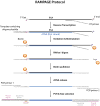RAMPAGE: promoter activity profiling by paired-end sequencing of 5'-complete cDNAs
- PMID: 24510412
- PMCID: PMC4372803
- DOI: 10.1002/0471142727.mb25b11s104
RAMPAGE: promoter activity profiling by paired-end sequencing of 5'-complete cDNAs
Abstract
RNA annotation and mapping of promoters for analysis of gene expression (RAMPAGE) is a method that harnesses highly specific sequencing of 5'-complete complementary DNAs to identify transcription start sites (TSSs) genome-wide. Although TSS mapping has historically relied on detection of 5'-complete cDNAs, current genome-wide approaches typically have limited specificity and provide only scarce information regarding transcript structure. RAMPAGE allows for highly stringent selection of 5'-complete molecules, thus allowing base-resolution TSS identification with a high signal-to-noise ratio. Paired-end sequencing of medium-length cDNAs yields transcript structure information that is essential to interpreting the relationship of TSSs to annotated genes and transcripts. As opposed to standard RNA-seq, RAMPAGE explicitly yields accurate and highly reproducible expression level estimates for individual promoters. Moreover, this approach offers a streamlined 2- to 3-day protocol that is optimized for extensive sample multiplexing, and is therefore adapted for large-scale projects. This method has been applied successfully to human and Drosophila samples, and in principle should be applicable to any eukaryotic system.
Keywords: RAMPAGE; expression profiling; high-throughput sequencing; promoter; transcription start site.
Copyright © 2013 John Wiley & Sons, Inc.
Figures

Similar articles
-
High-fidelity promoter profiling reveals widespread alternative promoter usage and transposon-driven developmental gene expression.Genome Res. 2013 Jan;23(1):169-80. doi: 10.1101/gr.139618.112. Epub 2012 Aug 30. Genome Res. 2013. PMID: 22936248 Free PMC article.
-
Using RAMPAGE to Identify and Annotate Promoters in Insect Genomes.Methods Mol Biol. 2019;1858:99-116. doi: 10.1007/978-1-4939-8775-7_9. Methods Mol Biol. 2019. PMID: 30414114
-
Integration of high-resolution promoter profiling assays reveals novel, cell type-specific transcription start sites across 115 human cell and tissue types.Genome Res. 2022 Feb;32(2):389-402. doi: 10.1101/gr.275723.121. Epub 2021 Dec 23. Genome Res. 2022. PMID: 34949670 Free PMC article.
-
The genome-wide identification of promoter regions in Toxoplasma gondii.Methods Mol Biol. 2015;1201:193-205. doi: 10.1007/978-1-4939-1438-8_11. Methods Mol Biol. 2015. PMID: 25388115
-
Global approaches for profiling transcription initiation.Cell Rep Methods. 2021 Sep 27;1(5):100081. doi: 10.1016/j.crmeth.2021.100081. Epub 2021 Sep 16. Cell Rep Methods. 2021. PMID: 34632443 Free PMC article. Review.
Cited by
-
FINDER: an automated software package to annotate eukaryotic genes from RNA-Seq data and associated protein sequences.BMC Bioinformatics. 2021 Apr 20;22(1):205. doi: 10.1186/s12859-021-04120-9. BMC Bioinformatics. 2021. PMID: 33879057 Free PMC article.
-
Building integrative functional maps of gene regulation.Hum Mol Genet. 2022 Oct 20;31(R1):R114-R122. doi: 10.1093/hmg/ddac195. Hum Mol Genet. 2022. PMID: 36083269 Free PMC article.
-
Global 5'-UTR RNA structure regulates translation of a SERPINA1 mRNA.Nucleic Acids Res. 2022 Sep 23;50(17):9689-9704. doi: 10.1093/nar/gkac739. Nucleic Acids Res. 2022. PMID: 36107773 Free PMC article.
-
High-quality chromosome scale genome assemblies of two important Sorghum inbred lines, Tx2783 and RTx436.NAR Genom Bioinform. 2024 Aug 9;6(3):lqae097. doi: 10.1093/nargab/lqae097. eCollection 2024 Sep. NAR Genom Bioinform. 2024. PMID: 39131819 Free PMC article.
-
TSSr: an R package for comprehensive analyses of TSS sequencing data.NAR Genom Bioinform. 2021 Nov 12;3(4):lqab108. doi: 10.1093/nargab/lqab108. eCollection 2021 Dec. NAR Genom Bioinform. 2021. PMID: 34805991 Free PMC article.
References
-
- Carninci P, Kvam C, Kitamura A, Ohsumi T, Okazaki Y, Itoh M, Kamiya M, Shibata K, Sasaki N, Izawa M, Muramatsu M, Hayashizaki Y, Schneider C. High-efficiency full-length cDNA cloning by biotinylated CAP trapper. Genomics. 1996;37:327–336. - PubMed
-
- Carninci P, Sandelin A, Lenhard B, Katayama S, Shimokawa K, Ponjavic J, Semple CAM, Taylor MS, Engstrom PG, Frith MC, Forrest ARR, Alkema WB, Tan SL, Plessy C, Kodzius R, Ravasi T, Kasukawa T, Fukuda S, Kanamori-Katayama M, Kitazume Y, Kawaji H, Kai C, Nakamura M, Konno H, Nakano K, Mottagui-Tabar S, Arner P, Chesi A, Gustincich S, Persichetti F, Suzuki H, Grimmond SM, Wells CA, Orlando V, Wahlestedt C, Liu ET, Harbers M, Kawai J, Bajic VB, Hume DA, Hayashizaki Y. Genome-wide analysis of mammalian promoter architecture and evolution. Nature Genetics. 2006;38:626–635. - PubMed
-
- Djebali S, Davis CA, Merkel A, Dobin A, Lassmann T, Mortazavi A, Tanzer A, Lagarde J, Lin W, Schlesinger F, Xue C, Marinov GK, Khatun J, Williams BA, Zaleski C, Rozowsky J, Roder M, Kokocinski F, Abdelhamid RF, Alioto T, Antoshechkin I, Baer MT, Bar NS, Batut P, Bell K, Bell I, Chakrabortty S, Chen X, Chrast J, Curado J, Derrien T, Drenkow J, Dumais E, Dumais J, Duttagupta R, Falconnet E, Fastuca M, Fejes-Toth K, Ferreira P, Foissac S, Fullwood MJ, Gao H, Gonzalez D, Gordon A, Gunawardena H, Howald C, Jha S, Johnson R, Kapranov P, King B, Kingswood C, Luo OJ, Park E, Persaud K, Preall JB, Ribeca P, Risk B, Robyr D, Sammeth M, Schaffer L, See LH, Shahab A, Skancke J, Suzuki AM, Takahashi H, Tilgner H, Trout D, Walters N, Wang H, Wrobel J, Yu Y, Ruan X, Hayashizaki Y, Harrow J, Gerstein M, Hubbard T, Reymond A, Antonarakis SE, Hannon G, Giddings MC, Ruan Y, Wold B, Carninci P, Guigo R, Gingeras TR. Landscape of transcription in human cells. Nature. 2012;489:101–108. - PMC - PubMed
MeSH terms
Substances
Grants and funding
LinkOut - more resources
Full Text Sources
Other Literature Sources
Research Materials

